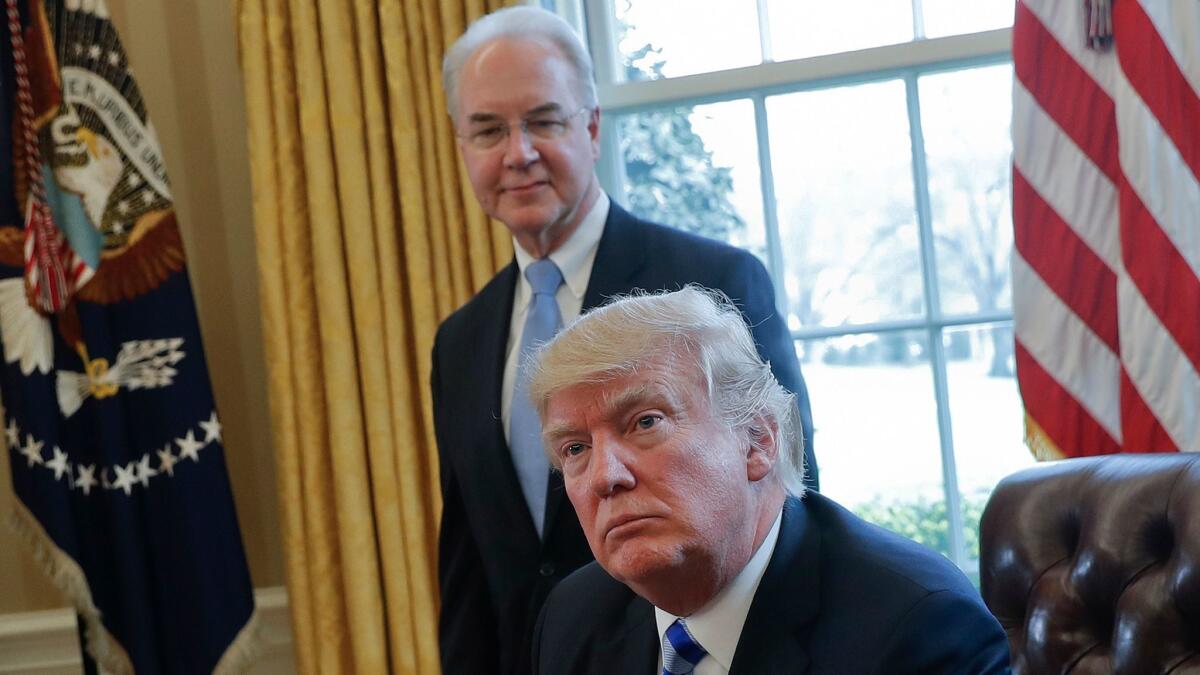Column: This one unbelievably expensive Iowa patient makes the case for single-payer healthcare

- Share via
Back in mid-2016, Iowa customers of Wellmark Blue Cross Blue Shield, the dominant company in the state’s individual insurance market, got a shock: Premium increases of 38% to 43% were in store for many of them for this year.
Three weeks ago they got a bigger shock: Wellmark was pulling out of Iowa’s individual market entirely, leaving the state with one company selling individual policies. Wellmark placed some of the blame on congressional Republicans’ failure to come up with a coherent repeal plan for the Affordable Care Act, leaving plans for 2018 in legislative limbo. With Wellmark’s departure, Iowa’s individual market may be down to a single insurer next year.
But Iowa has another problem that appears to be unique for a state its size: one single state resident whose care costs $1 million a month. That’s enough to all but destroy an individual insurance market that comprises about 30,000 customers. Indeed, that one patient’s care, according to Wellmark, was responsible for 10 percentage points of the 43% premium increase this year.
The idea of single-payer is that there’s just one risk pool. That’s what makes the care of very high-cost patients affordable.
— Single-payer advocate Steffie Wollhandler
The patient has not been identified; nor has his or her medical condition, beyond a statement by Wellmark that he or she suffers from a complicated and severe genetic disorder. Speculation in the healthcare industry about the reasons for the expense focuses on the cost of the patient’s medications.
The important aspect of the Iowa case is what it tells us about the importance of spreading risk in the healthcare market, and the limitations of the Republican nostrum of segregating seriously ill patients into high-risk pools. The idea is to keep their costs from driving up everyone else’s premiums.
The case also points directly to the benefits of a single-payer healthcare system. “The idea of single-payer is that there’s just one risk pool,” says Steffie Woolhandler, a New York physician who is co-founder of Physicians for a National Health Program, the nation’s leading advocacy group for single-payer healthcare. “That’s what makes the care of very high-cost patients affordable.”
Before the Affordable Care Act, obviously, patients like our unnamed Iowan would be in mortal trouble. He or she would likely have been rendered uninsurable either by outright rejection or by surcharges that would make insurance unaffordable. Even if he or she had obtained coverage, the usual pre-ACA lifetime benefit limits of $1 million-$5 million would have kicked in early in the first policy year.
“Most likely the patient would quickly run through their private insurance,” conjectures health insurance expert David Anderson of Duke. “At that point, s/he would most likely either qualify for Medicaid, put on charity care or left to die.” (How the patient received treatment before the ACA isn’t known.)
Anderson calls this “fundamentally an uninsurable scenario” in which “a high cost risk pool or invisible reinsurance or a prospective re-assignment system would make sense.” These are all elements of a Republican Obamacare repeal plan put forth earlier this month and based, if haphazardly, on a program Maine created before the ACA. Any of these options would spread the patient’s cost to a pool larger than the one consisting of Wellmark’s roughly 30,000 Iowa customers.
But there are three limitations to these ideas even if the pool encompasses an entire state, Anderson observes. One is that some states are so small that even one such patient will break the bank. California could manage it, Wyoming could not, Iowa will struggle.
The other is that high-cost patients don’t always appear randomly, but sometimes in clusters. Zika cases, for example, will show up heavily in Southeastern states with inadequate Medicaid funding, he argues. And genetic diseases of the sort suffered by the Iowa patient may be geographically concentrated in part because “most people live near their families rather than being randomly distributed.”
The third problem is that high-risk pools and reinsurance funds tend to be hopelessly underfunded. This was the case in most of the 35 states with high-risk pools prior to the Affordable Care Act, including California. Without sufficient public funding to cover all their high-cost residents adequately, most imposed waiting lists for coverage, time limits on eligibility, and premiums so high that many patients couldn’t afford them at all. The proposals for high-risk pools coming from congressional Republicans are similarly stingy.
“What high-risk pool could tolerate a patient costing a million dollars a month?” asks Woolhandler. “It would have to be a huge pool.”
The only fair and effective way to manage such patients, especially the few with truly stratospheric medical costs, is to make them part of a nationwide pool. A risk pool on that scale would represent the functional equivalent of single-payer healthcare. And that’s leaving aside some of the other virtues single-payer advocates cite, including the ability to negotiate prices on pharmaceuticals with the bargaining power of the entire country, and the virtual elimination of insurance company and provider billing office overhead.
As unusual as the Iowa patient may be, extremely high-cost treatments may not be extreme outliers for much longer. Drug treatments for “orphan” diseases with a few hundred or thousand cases are becoming more expensive, but so are drugs for more common conditions such as cancer or high-cholesterol disease. State budgets are going to be increasingly hard-pressed to cover these costs. The healthcare cost crisis is spreading nationwide, which makes it a national problem demanding a national — meaning a federal — solution.
Keep up to date with Michael Hiltzik. Follow @hiltzikm on Twitter, see his Facebook page, or email michael.hiltzik@latimes.com.
Return to Michael Hiltzik’s blog.
More to Read
Inside the business of entertainment
The Wide Shot brings you news, analysis and insights on everything from streaming wars to production — and what it all means for the future.
You may occasionally receive promotional content from the Los Angeles Times.











